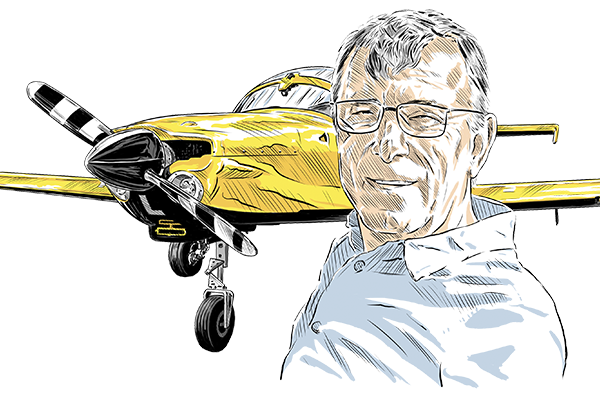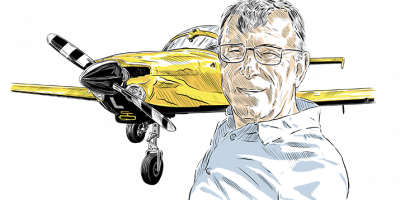Flying an aircraft which can climb to an altitude that requires oxygen opens up a world of options. Terrain, ice, turbulence and the general chaos of lower airspace often just disappear in exchange for some ‘time in the climb’ – and a bit of faff with a mask or cannula. But the risks aren’t to be taken lightly. The line between smooth cruise flight and hypoxia can be precariously thin.
Accident 1
The pilot of a Cessna 208B aircraft was contracted to ferry the aeroplane from Jandakot Airport, Australia, to the US. The aircraft left Jandakot Airport and landed in Alice Springs. Late the next morning, the aircraft left Alice Springs for Weipa, Queensland, where the pilot refuelled and stayed overnight.
The following morning, the pilot conducted a one-hour flight to Horn Island, Queensland. About an hour later, the aircraft departed Horn Island with the planned destination of Guam, Micronesia. While en route, the pilot sent a message to the aircraft operator advising that he would not land in Guam, but would continue another 118nm to Saipan, Northern Mariana Islands.
“The pilot didn’t respond to the intercept according to international protocols”
The next morning the pilot refuelled the aircraft and detected damage to the propeller anti-ice boot. The aircraft was delayed for more than a week while an engineer travelled to Saipan and replaced the anti-ice boot. About an hour after departure, the aircraft levelled out at flight level FL220. Once in the cruise, the pilot sent a message that he was at 22,000ft, had a tailwind and the weather was clear. This was followed by a message at 0010 that he was at FL220, with a true airspeed of 167kt and fuel flow of 288lb/hr. At 0121, while overhead reporting point TEGOD, the pilot contacted Tokyo Radio flight information service on HF radio. The pilot was next due to report when the aircraft reached reporting point SAGOP, which the pilot estimated would occur at 0244. GPS recorded track showed that the aircraft passed SAGOP at 0241, but the pilot did not contact Tokyo Radio as expected. At 0249, Tokyo Radio made several attempts to communicate with the pilot on two different HF frequencies, but did not receive a response. Tokyo Radio made further attempts to contact the pilot between 0249 and 0251, as well as at 0341, 0351 and 0405.
About 4.5 hours after the pilot’s last communication, two Japan Air Self-Defense Force (JASDF) aircraft intercepted the aircraft. The pilot did not respond to the intercept in accordance with international intercept protocols, either by rocking the aircraft wings or turning, and the aircraft continued to track at FL220 on its planned flight route. The JASDF pilots were unable to see into the cockpit to determine whether the pilot was in his seat or whether there was any indication that he was incapacitated. The JASDF pilots flew around the aircraft for about 30 minutes, until it descended into cloud. At 0626 UTC, the aircraft’’s GPS tracker stopped reporting, with the last recorded position at FL220, about 54nm off the Japanese coast and 318nm short of the destination airport.
Radar data showed that the aircraft descended rapidly from this point and collided with water about two minutes later. The Japanese authorities launched a search and rescue mission and within two hours, searchers found the aircraft’s rear passenger door. The search continued until the next day when a typhoon passed through the area, and the search was suspended for two days. After resuming, the search continued for nearly a month with no further parts of the aircraft found. The pilot was not located.
The aircraft was fitted with an oxygen system with a 3.3 cubic metre capacity oxygen cylinder located in the fuselage tail cone. The cylinder had been tested and maintained in accordance with requirements, was within its 15-year life limit and had been filled with aviator breathing oxygen (ABO), prior to the aircraft’s departure from Jandakot.
Oxygen from the cylinder was first reduced to 70 psi by a pressure regulator and then by two altitude-compensating regulators located between the pressure regulator and oxygen supply lines, which automatically varied the flow of oxygen to the masks with changes in altitude. A remote shut-off valve in the overhead console was used to shut off the supply of oxygen to the system when not in use.
A microphone-equipped mask with a vinyl plastic hose and flow indicator was stored under the pilot’s seat. It was observed to be in its packaging (unused) when the aircraft was in Saipan. The pilot had a battery-operated Mountain High (MH) Pulse-Demand Electronic Delivery System (EDS). The EDS unit supplied a measured pulse of oxygen at the beginning of each inhalation and was oxygen-compensating (increasing flow with altitude).
The pilot preferred to use a nasal cannula for oxygen delivery, and he intended to use it for the ferry flight. This was consistent with the supplied oxygen mask being unused before departing Saipan, despite two previous sectors above 18,000ft. The pilot had also sent a message on the previous sector, indicating that he was using the cannula at 19,000ft.
The EDS was required to be operated with an oxygen inlet pressure between 16-20 psi, which could be achieved with an in-line regulator. The manual included the warning that higher pressure ‘will not only compromise the performance of the EDS, but is likely to damage the internal breathing sensor, rendering the EDS unit inoperable’. The pilot did not have an in-line regulator for the flight. At altitudes above 17,000ft, the aircraft’s system provided oxygen at 21.55 psi, which was higher than the EDS inlet pressure range. At 20,000ft, this increased 24.45 psi.
Accident 2
A Piper PA-31 aircraft was deployed to the Okanagan Valley, British Columbia, Canada, for survey activities, consisting of flying over selected areas at 3,600ft above the highest terrain at a ground speed of 150kt. For each flight, a survey equipment technician sat in the cabin of the aircraft and operated the various pieces of equipment for the survey, and the pilot sat in the front left seat of the cockpit. Each survey mission averaged six hours of flight time.
“The airspeed reached 91 KIAS, and the stall horn began to sound intermittently”
The aircraft departed Penticton Airport (CYYF), BC, with full fuel and began survey operations, to the east of CYYF. The survey portion of the flight lasted for two hours, with the aircraft being flown at 10,000ft for the final hour. Once the survey was completed, the pilot air-filed an instrument flight rules flight plan to Calgary/Springbank Airport (CYBW), Alberta. Air traffic control (ATC) issued a clearance for the pilot to climb to and maintain an altitude of 15,000ft and to proceed directly to the IGVEP waypoint.
During the climb through 11,000ft, the autopilot was selected ON, and the pilot switched the fuel selectors from INBOARD to OUTBOARD. Shortly after the aircraft reached 15,000ft, at 1256, the pilot selected the fuel pumps ON, in accordance with the aircraft flight manual (AFM), and left them ON for the rest of the flight. The autopilot altitude hold (ALT) mode was selected.
The pilot then assisted the survey technician in activating the portable oxygen system. Two minutes later, the pilot put an oxygen mask up to his face, and, a few seconds later, he put it down.
At 1328, the autopilot ALT mode disengaged. Over the following 47 seconds, the aircraft started to climb from an altitude of 15,000ft, assigned by ATC, to 15,400ft. It then began a descent, reaching a peak vertical speed of 3200fpm and an acceleration of 0.5g. After nine seconds of descent, the pilot levelled off at 15,000ft (with an acceleration of 1.7g) and engaged the ALT mode.
At 1330:55, ATC instructed the pilot to descend to 14,000ft. At 1331, the pilot switched the fuel tanks from the OUTBOARD to the INBOARD position, in accordance with the AFM, selected pitch mode on the autopilot and began the descent to 14,000ft. The aircraft entered cloud during the descent and levelled off at 14,000ft 90 seconds later, at which point ALT mode was selected.
At 1333, ATC asked the pilot for his indicated airspeed (IAS), but the pilot read back the altitude of 14,000ft. ATC, once again, asked for the IAS, but this time the pilot read back the ground speed of 170kt instead – the actual IAS was 140kt.
ATC then asked the pilot to slow to 150kt indicated airspeed (KIAS) and to descend to 13,000ft. A few seconds later, the manifold pressure (MP) on both engines decreased, which resulted in the left-hand MP gauge indicating an MP of 18 inches of mercury (inHg) and a fuel flow of 22 US gallons per hour, and the right-hand engine indicating an MP of 15 inHg and a fuel flow of 14 US gallons per hour.
After the power reduction, the autopilot ALT mode disengaged. The navigation and pitch mode, as well as the flight director mode, remained ON. The aircraft’s airspeed decreased to below the single-engine inoperative best rate-of-climb speed (Vyse) of 97 KIAS, and the aircraft maintained an altitude of 13,900ft.
The airspeed reached 91 KIAS, and the stall horn began to sound intermittently. The IAS began to increase as the MP for the left engine increased to 34 inHg with a fuel flow of 38 US gallons per hour. At the same time, the right MP gauge indicated 20 inHg and a fuel flow of less than 10 US gallons per hour.
The aircraft began a brief descent, and the airspeed increased to 100 KIAS. At 1334:40 the aircraft deviated to the right of the intended track and its altitude decreased to 13,500ft. It then began to climb and the IAS began to decrease below VYSE again. At 1335:43, ATC called the pilot to confirm that he was going to the IGVEP waypoint.
The stall warning horn was sounding continuously. The pilot replied that there was a problem with the right engine. Shortly afterwards, the airspeed decreased to 71 KIAS, and the aircraft departed controlled flight and went into a right-hand spin.
As the aircraft descended through 11,500ft, ATC asked the pilot to report his situation. The pilot declared an emergency. The aircraft kept spinning and, during the spin, the pilot occasionally input full left and partial right aileron on the control column.
The aircraft did not recover from the spin. It completed 7.5 revolutions before colliding with terrain at 10,000ft.
The pilot didn’t continuously use oxygen above 13,000ft and likely became hypoxic as he climbed to/and maintained an altitude of 13,000ft. The pilot didn’t identify his symptoms or take action to restore his oxygen supply, resulting in degradation of his ability to manage normal flying tasks.





